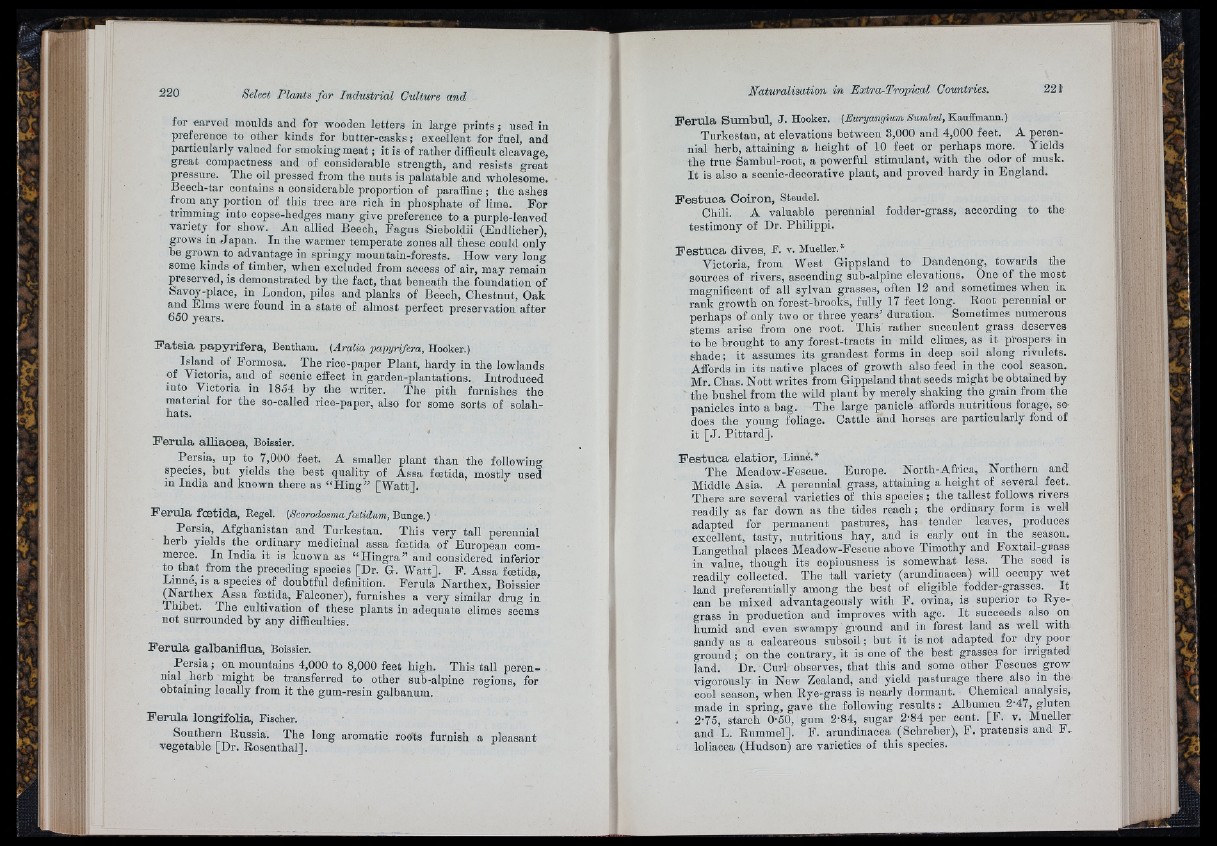
for carved moulds and for wooden letters in large p rin ts ; nsed in
preference to other kinds for butter-casks; excellent for fuel, and
particularly valued for smoking m e a t; it is of rather difficult cleavage,
great compactnep and of considerable strength, and resists great
pressure. The oil pressed from the nuts is palatable and wholesome.
Beech-tar contains a considerable proportion of paraffine ; the ashes
from any portion of this tree are rich iu phosphate of lime. For
trimming into copse-hedges many give preference to a purple-leaved
variety for show. An allied Beech, Fagus Sieboldii (Endlicher),
grows in J apan. In the warmer temperate zones all these could only
be grown to advantage in springy mountain-forests. How very long
some kinds of timber, wlieu excluded from access of air, may remain
preserved, is demonstrated by the fact, th a t beneath the foundation of
Savoy-place, in Loudon, piles and planks of Beech, Chestnut, Oak
and Elms were found in a state of almost perfect preservation after
650 years.
Eatsia papyrifera, Bentham. (Aralia papyrifera. Hooker.)
Island of Formosa. The rice-paper Plant, hardy in the lowlands
of Victoria,^ and of scenic effect in garden-plantations. Introduced
into Victoria in 1854 by the writer. The pith furnishes the
material for the so-called rice-paper, also for some sorts of solah-
hats.
Ferula alliacea, Boissier.
Persia, up to 7,000 feet. A smaller plant than the following
species, but yields the best quality of Assa foetida, mostly used
in India and known there as “ K in g ” [W a tt].
Ferula foetida. Regel. (ScorodosmafatidumjPymge.)
Persia, Afghanistan and Turkestan. This very tall perennial
herb yields the ordinary medicinal assa foetida of European commerce.
In India it is known as “ H in g ra ” and considered inferior
to th a t from the preceding species [Dr. G. W a tt], F. Assa foetida,
Lmne, is a species of doubtful definition. Ferula Narthex, Boissier
(Narthex Assa foetida. Falconer), furnishes a very similar drug in
Thibet. The cultivation of these plants in adequate climes seems
not surrounded by any difficulties.
Ferula galbaniflua, Boissier.
_ P e rs ia ; on mountains 4,000 to 8,000 feet high. This tall perennial
herb might be transferred to other sub-alpine regions, for
obtaining locally from it the gum-resin galbanum.
Ferula longifolia, Fischer.
Southern Russia. The long aromatic roots furnish a pleasant
vegetable [Dr. Rosenthal].
Ferula Sumbul, J. Hooker. ( E u r y a n g i u m S u m h u l . 'K a u e m a m i . )
Turkestan, at elevations between 3,000 and 4,000 feet. A perennial
herb, attaining a height of 10 feet or perhaps more. Yields
the true Sambul-root, a powerful stimulant, with the odor of musk.
I t is also a scenic-decorative plant, and proved hardy in England.
fodder-grass, according to the
F e s t u c a C o iro n , Steudel.
Chili. A valuable perennial
testimony of Dr. Philippi.
F e s t u c a d iv e s , F. v. Mueller.*
Victoria, from West Gippsland to Dandeuong, towards the
sources of rivers, ascending sub-alpine elevations. One of the most
magnificent of all sylvan grasses, often 12 and sometimes when in
rank growth on forest-brooks, fnlly 17 feet long. Root perennial or
perhaps of only two or three years’ duration. Sometimes numerous
stems arise from one root. This rather succulent grass deserves
to be brought to any forest-tracts in mild climes, as it prospers- in
shade; it assumes its grandest forms in deep soil along rivulets.
Affords in its native places of growth also feed in the cool season.
Mr. Chas. N o tt writes from Gippsland th a t seeds might be obtained by
the bushel from the wild plant by merely shaking the grain from the
panicles into a bag. The large panicle affords nutritious forage, so-
does the yonng foliage. Cattle and horses are particularly fond of
it [ J . P itta rd ].
P e s t u c a e la tio r , Linné.*
The Meadow-Fescue. Europe. North-Africa, Northern and
Middle Asia. A perennial grass, attaining a height of several feet.
There are several varieties of this species ; the tallest follows rivers
readily as far down as the tides reach ; the ordinary form is well
adapted for permanent pastures, has tender leaves, produces
excellent, tasty, nutritious hay, and is early out in the season.
Langethal places Meadow-Fescue above Timothy and Foxtail-grass
in value, though its copiousness is somewhat less.^ The seed is
readily collected. The tall variety (arundinacea) will occupy wet
land preferentially among the best of eligible fodder-grasses. I t
can be mixed advantageously with F. ovina, is superior to Ryegrass
in production and improves with age. I t succeeds also on
humid and even swampy ground and in forest land as well with
sandy as a calcareous subsoil ; but it is not adapted for dry poor
ground ; on the contrary, it is one of the best grasses for irrigated
land. Dr. Curl observes, th a t this and some other Fescues grow
vigorously in New Zealand, and yield pasturage there also in the
cool season, when Rye-grass is nearly dormant. Chemical analysis,
made in spring, gave the following results : Albumen 2‘47, gluten
. 2-75, starch 0-50, gum 2’84, sugar 2-84 per cent. [F. v. Mueller
and L. Enmmel]. Ik arundinacea (Schreher), F . pratensis and F..
loliacea (Hudson) are varieties of this species.
IS-
(li: